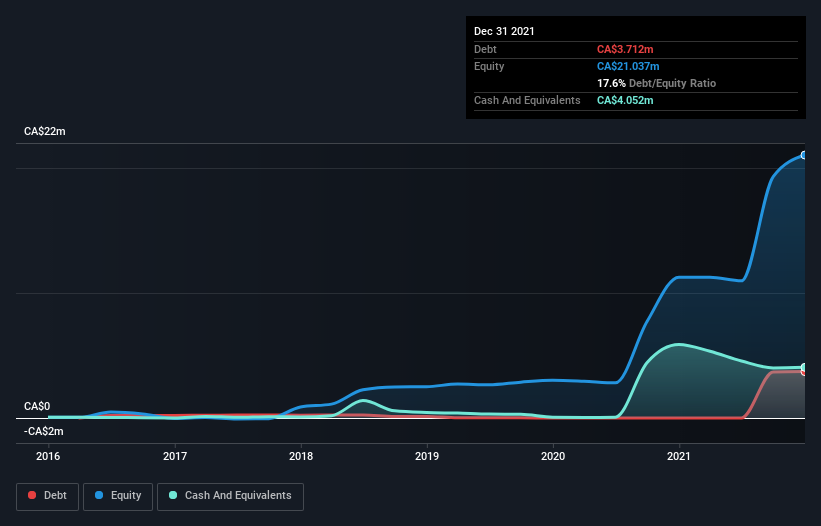Is Stratabound Minerals (CVE:SB) Using Debt Sensibly?
Some say volatility, rather than debt, is the best way to think about risk as an investor, but Warren Buffett famously said that 'Volatility is far from synonymous with risk.' When we think about how risky a company is, we always like to look at its use of debt, since debt overload can lead to ruin. We note that Stratabound Minerals Corp. (CVE:SB) does have debt on its balance sheet. But is this debt a concern to shareholders?
When Is Debt A Problem?
Debt assists a business until the business has trouble paying it off, either with new capital or with free cash flow. Ultimately, if the company can't fulfill its legal obligations to repay debt, shareholders could walk away with nothing. While that is not too common, we often do see indebted companies permanently diluting shareholders because lenders force them to raise capital at a distressed price. Of course, debt can be an important tool in businesses, particularly capital heavy businesses. When we examine debt levels, we first consider both cash and debt levels, together.
View our latest analysis for Stratabound Minerals
What Is Stratabound Minerals's Debt?
As you can see below, at the end of December 2021, Stratabound Minerals had CA$3.71m of debt, up from none a year ago. Click the image for more detail. But on the other hand it also has CA$4.05m in cash, leading to a CA$339.7k net cash position.
A Look At Stratabound Minerals' Liabilities
According to the last reported balance sheet, Stratabound Minerals had liabilities of CA$5.94m due within 12 months, and liabilities of CA$13.9k due beyond 12 months. Offsetting these obligations, it had cash of CA$4.05m as well as receivables valued at CA$115.5k due within 12 months. So its liabilities total CA$1.78m more than the combination of its cash and short-term receivables.
Given Stratabound Minerals has a market capitalization of CA$9.63m, it's hard to believe these liabilities pose much threat. However, we do think it is worth keeping an eye on its balance sheet strength, as it may change over time. Despite its noteworthy liabilities, Stratabound Minerals boasts net cash, so it's fair to say it does not have a heavy debt load! There's no doubt that we learn most about debt from the balance sheet. But it is Stratabound Minerals's earnings that will influence how the balance sheet holds up in the future. So if you're keen to discover more about its earnings, it might be worth checking out this graph of its long term earnings trend.
Since Stratabound Minerals has no significant operating revenue, shareholders probably hope it will develop a valuable new mine before too long.
So How Risky Is Stratabound Minerals?
Statistically speaking companies that lose money are riskier than those that make money. And the fact is that over the last twelve months Stratabound Minerals lost money at the earnings before interest and tax (EBIT) line. Indeed, in that time it burnt through CA$3.5m of cash and made a loss of CA$1.6m. With only CA$339.7k on the balance sheet, it would appear that its going to need to raise capital again soon. Overall, we'd say the stock is a bit risky, and we're usually very cautious until we see positive free cash flow. When analysing debt levels, the balance sheet is the obvious place to start. However, not all investment risk resides within the balance sheet - far from it. To that end, you should learn about the 5 warning signs we've spotted with Stratabound Minerals (including 4 which shouldn't be ignored) .
When all is said and done, sometimes its easier to focus on companies that don't even need debt. Readers can access a list of growth stocks with zero net debt 100% free, right now.
Have feedback on this article? Concerned about the content? Get in touch with us directly. Alternatively, email editorial-team (at) simplywallst.com.
This article by Simply Wall St is general in nature. We provide commentary based on historical data and analyst forecasts only using an unbiased methodology and our articles are not intended to be financial advice. It does not constitute a recommendation to buy or sell any stock, and does not take account of your objectives, or your financial situation. We aim to bring you long-term focused analysis driven by fundamental data. Note that our analysis may not factor in the latest price-sensitive company announcements or qualitative material. Simply Wall St has no position in any stocks mentioned.

 Yahoo Finance
Yahoo Finance 
